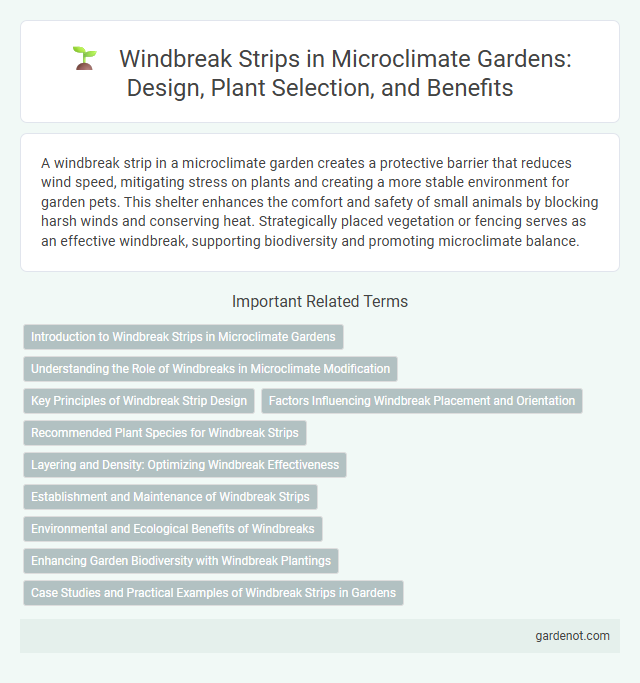A windbreak strip in a microclimate garden creates a protective barrier that reduces wind speed, mitigating stress on plants and creating a more stable environment for garden pets. This shelter enhances the comfort and safety of small animals by blocking harsh winds and conserving heat. Strategically placed vegetation or fencing serves as an effective windbreak, supporting biodiversity and promoting microclimate balance.
Introduction to Windbreak Strips in Microclimate Gardens
Windbreak strips in microclimate gardens serve as strategic barriers that reduce wind speed, protecting plants from desiccation and temperature fluctuations. These strips, often composed of dense shrubs or trees, enhance humidity and create sheltered zones that promote healthier plant growth and increased biodiversity. Implementing windbreak strips optimizes microclimate conditions, improving crop yield and garden resilience.
Understanding the Role of Windbreaks in Microclimate Modification
Windbreak strips reduce wind speed, creating calmer microclimates that protect plants from desiccation and mechanical damage. By altering airflow patterns, these barriers enhance soil moisture retention and moderate temperature fluctuations within garden spaces. Effective windbreaks improve plant growth and increase biodiversity by creating sheltered environments in otherwise exposed areas.
Key Principles of Windbreak Strip Design
Effective windbreak strip design relies on optimizing height, density, and length to reduce wind velocity and protect microclimates. Selecting plant species with varying heights and dense foliage creates a layered barrier that enhances wind resistance and promotes biodiversity. Proper spacing and orientation perpendicular to prevailing winds maximize the strip's wind-filtering efficiency and minimize turbulence.
Factors Influencing Windbreak Placement and Orientation
Windbreak strip placement and orientation depend heavily on prevailing wind direction, local topography, and vegetation density to effectively reduce wind velocity and protect microclimates. Soil drainage and sunlight exposure also influence the selection of plant species and positioning to ensure optimal growth and stability. Strategic arrangement considers wind speed variability throughout the year, maximizing shelter benefits for crops and reducing soil erosion.
Recommended Plant Species for Windbreak Strips
Recommended plant species for windbreak strips include fast-growing evergreens such as Thuja occidentalis (arborvitae), Pinus sylvestris (Scots pine), and Juniperus communis (common juniper) due to their dense foliage and tolerance to wind exposure. Deciduous options like Carpinus betulus (European hornbeam) and Corylus avellana (hazel) provide seasonal wind protection while supporting biodiversity. Planting a diverse mix of shrubs and trees enhances the strip's effectiveness by creating multi-layered barriers that reduce wind speed and protect the microclimate garden environment.
Layering and Density: Optimizing Windbreak Effectiveness
Layering and density are critical for optimizing the effectiveness of windbreak strips in microclimate gardens, as multiple vegetation layers create complex barriers that reduce wind speed and turbulence. Dense foliage combined with tall trees and low shrubs enhances wind resistance by disrupting airflow at various heights, which stabilizes temperature and moisture levels. Proper arrangement of plant species with varying heights and thickness ensures maximum protection for sensitive garden areas, improving plant health and growth.
Establishment and Maintenance of Windbreak Strips
Establishing windbreak strips involves selecting dense, native shrubs or trees with multi-layered canopies to reduce wind speed effectively. Regular maintenance includes pruning to maintain optimal height and density, removing dead or diseased branches, and monitoring for pest infestations to ensure continued wind protection. Proper irrigation during establishment and mulching around plants support healthy root development and windbreak longevity.
Environmental and Ecological Benefits of Windbreaks
Windbreak strips enhance environmental stability by reducing soil erosion and conserving moisture, which supports healthier plant growth and biodiversity. These natural barriers improve microclimate conditions, lowering wind speeds that can cause damage and stress to surrounding vegetation. Windbreaks also provide critical habitats for wildlife, promoting ecological balance and increasing landscape resilience.
Enhancing Garden Biodiversity with Windbreak Plantings
Windbreak strips composed of diverse native shrubs and trees create shelter that reduces wind speed and microclimate stress, fostering an ideal habitat for pollinators, birds, and beneficial insects. Selecting species with staggered blooming periods and varying heights maximizes year-round food sources and nesting opportunities, amplifying garden biodiversity. Strategic placement of windbreak plantings also improves soil moisture retention and prevents erosion, supporting a resilient and thriving microclimate garden ecosystem.
Case Studies and Practical Examples of Windbreak Strips in Gardens
Windbreak strips in microclimate gardens have proven effective in reducing wind speed by up to 60%, as demonstrated in case studies from temperate regions. Practical examples include strategically planted hedgerows and dense shrubbery that protect vulnerable plants, increase humidity, and enhance soil moisture retention. These windbreak strips contribute to improved plant growth, yield, and overall garden resilience against harsh weather conditions.
Windbreak strip Infographic

 gardenot.com
gardenot.com